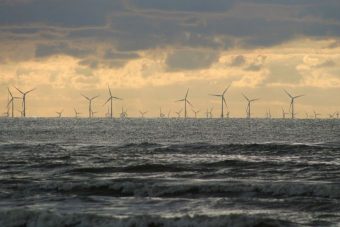
New research from the Carnegie Institution for Science has highlighted the “considerable opportunity” of developing offshore wind in the open ocean, which could generate up to three to five times as much energy as wind farms on land.
Carnegie Institution for Science researchers Anna Possner and Ken Caldeira set out to determine the potential for offshore wind energy on the open ocean and found that in one scenario, open ocean-based offshore wind farms could generate at least three times more power than large wind farms on land.
To be clear, the new research, which was published in the journal Proceedings of the National Academy of Sciences, is not referring to traditional offshore wind farms — which, in theory, may soon be called near-shore wind farms. Rather, Possner and Caldeira set out to investigate the potential of open ocean, deep water wind farms — focusing primarily on the North Atlantic Ocean.
The research set out to determine the answer to a specific question; quoting from the study itself;
“Wind speeds over open ocean areas are often higher than those in the windiest areas over land, which has motivated a quest to develop technologies that could harvest wind energy in deep water environments. However, it remains unclear whether these open ocean wind speeds are higher because of lack of surface drag or whether a greater downward transport of kinetic energy may be sustained in open ocean environments.”
“Are the winds so fast just because there is nothing out there to slow them down?” Caldeira asked. “Will sticking giant wind farms out there just slow down the winds so much that it is no better than over land?”
According to the research, the majority of energy captured by large wind farms originates high up in the atmosphere and is transported downwards to the surface where the turbines are able to generate the energy from the strong winds. The authors point to other research which has concluded that the maximum rate of electricity generation for land-based wind farms is limited by the rate at which the energy is moved down towards the ground from high up in the atmosphere.
“The real question is can the atmosphere over the ocean move more energy downward than the atmosphere over land is able to?” Caldeira said.
By focusing on the North Atlantic, Possner and Caldeira found that the drag introduced by wind turbines would not slow winds down as much as they do on land, due largely to the tremendous amounts of heat pouring out of the North Atlantic Ocean into the upper atmosphere — especially during the winter.
“We found that giant ocean-based wind farms are able to tap into the energy of the winds throughout much of the atmosphere, whereas wind farms onshore remain constrained by the near-surface wind resources,” Possner explained.
Interestingly, their research found that the tremendous amount of energy generated in their models was incredibly seasonal. The North Atlantic winds produce tremendous amounts of energy in winter — enough to meet all of civilization’s energy needs, in fact — but that in summer they barely produce enough to cover Europe’s electricity demand, or the United States’.
Commercializing such deep water offshore wind technology is in its relative infancy — the most obvious idea being floating offshore wind farms, which don’t need to be built onto the seafloor. One example is the Hywind Scotland pilot park, a floating offshore wind farm being built 25 kilometers off the coast of Peterhead in Aberdeenshire, Scotland. Siemens Gamesa completed the installation of the five 6 MW floating wind turbines which were then towed from Norway to Scotland.
Source: cleantechnica.com

